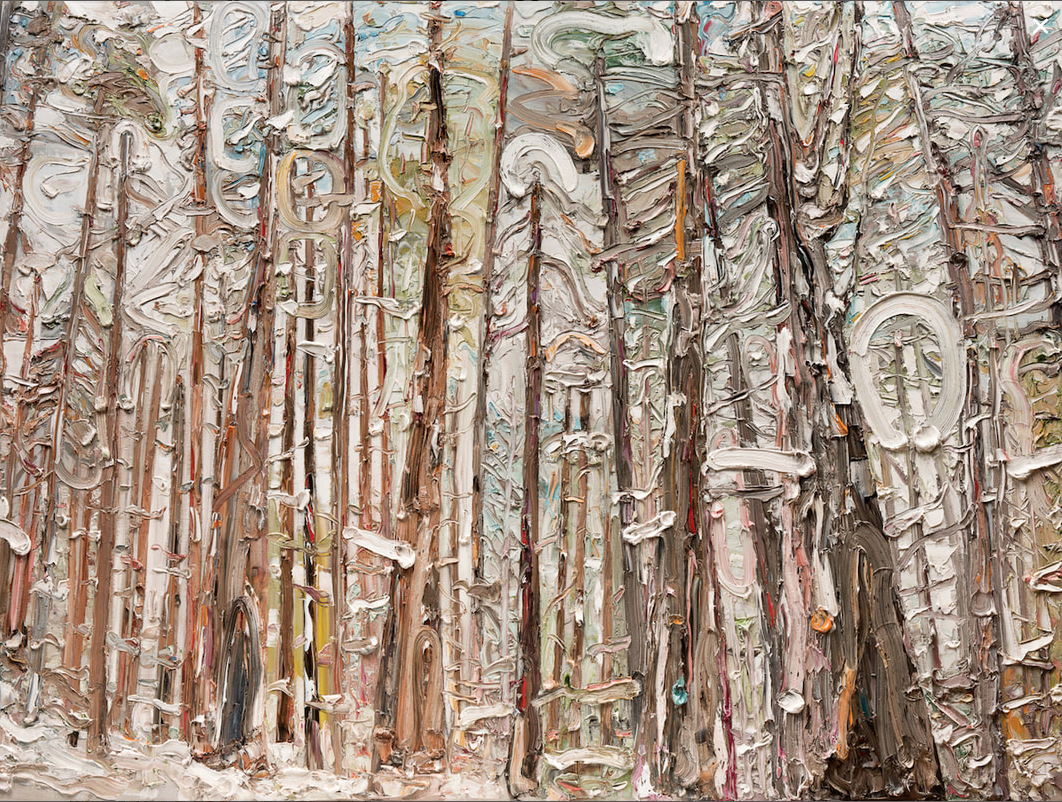When I first saw Deon Venter’s painting, I immediately thought about the title's (“In the Avatar”) significance to the scene unfolding before my eyes. The painting is based on a real location, the Avatar Forest, near Port Renfrew, on the West Coast of Vancouver Island, so I knew the title had a literal meaning. Perhaps here, I thought, in Freud's (apocryphal) words, "a cigar is just a cigar." But I knew about the origins of the word "avatar" in Hindu religion, as a manifestation of the divine in human form, a divinity embodied. The metaphoric connotations of the name are obvious. Yet, there are no human forms in this painting, no incarnated gods, only an agglomeration, a thick impasto of vertical and horizontal lines, semi-circles, oval shapes, squiggles and scratches densely layered over the surface of the canvas. Taken together, these shapes and their colours—a rich combination of browns, green and blues, sprinkled with red, pink and orange dabs—convey the sumptuousness (the thickness of the paint, the corrugated surfaces) and majesty of a forest, a living and growing forest in all its physical grandeur. There is no human grandeur here, no divinity incarnated, but the vastness of nature— Nature's spirit, embodied in the trees and given expression in the semi-circles and oval shapes punctuating the canvas: an arcane language of undecipherable symbols.
More important than the image represented (or abstracted is perhaps a better description ), for me, is the experience this painting makes available. Looking at this forest of rich colours and thick textures, I am transported into the experience of “being” in the forest—as a part of the forest’s "being" and as a "being" that is separate from it—a feeling that is both exhilarating and unsettling. To enter the avatar, then, in the way that Venter’s painting conceives of it, is to enter another body, to be re-embodied, which is also a way to have access to another, more intense way of being. What are bodies but material containers for our “being,” for the stirrings of our internal world? The forest as body, as avatar, another space where these stirrings, this awareness of being alive and fully present in the world, can be experienced in all their breathtaking and troubling intensity. Now that I am “in the avatar,” I sense the painting’s (the forest’s) heavy presence, its motionless materiality, but also its vitality and exuberance, what literary critic Gaston Bachelard calls the forest’s “intimate immensity” or the “immediate immensity of its depth,” which is also the feeling that there is “something else to be expressed besides what is offered for objective expression.” (The Poetics of Space, 186) This “something else” is the “sense of mystery” that, according to philosopher David E. Cooper, permeates our experience of being in the world, of becoming part of an emergent world we cannot comprehend, as it escapes “objective expression," but we still feel at home in.
So the emergence of a world —the presencing of anything for experience—cannot be explained or described. It is a mysterious upsurge, a coming to be, from a source that is itself mysterious. (David E. Cooper, Senses of Mystery: Engaging with Nature and the Meaning of Life, 50)
Venter’s “In the Avatar,” with its tangled mess of lines and squiggles, long and short brush strokes, thickly layered and scratched surfaces and arcane symbols captures the “mysterious upsurge,” the “coming to be” of the world that Cooper so beautifully describes in these lines. This is what an emergent world looks like and feels like. This is what "being" in the presence of the divine (the original meaning of "avatar") really means: to be enclosed, embodied, bathed in the source of things; to be gathered and then released into being, a being that is as physical and material as it is mysterious and ineffable.
In Cooper’s words (and Venter’s imagination) to be "In the Avatar,” is “To experience this gathering … [this] mystery of emergence, an epitome of that larger coming to presence that is the human world as a whole.” (Cooper, 65)
Sometimes, titles, like the paintings they name, really are portals to the imagination.
"In the Avatar," Deon Venter, oil on canvas
"Deon Venter exhibits internationally in leading contemporary fine art galleries. His work is included in the permanent collections of museums, national galleries, and notable public and private collections in Canada, the U.S.A., the U.K., Europe and Africa.
Between 2002 and 2008, Venter’s paintings have been exhibited regularly at international art fairs on three continents. His unique content, method and use of material has stirred the interest of collectors worldwide.
His critically acclaimed work has been reviewed in numerous newspapers and art magazines in Canada, South Africa and the U.S.A.
Venter was born in 1953 in the Eastern Cape of South Africa. He graduated from Port Elizabeth School of Art and Design in 1976. He lectured at the University of Fort Hare, Republic of the Ciskei, and the Port Elizabeth School of Art and Design, South Africa.
Venter immigrated to Canada in 1989 and currently lives on Saltspring Island, British Columbia." Courtesy of Venter Gallery, Saltspring Island, BC. Special thanks to gallery director Anthony Matthews.

 RSS Feed
RSS Feed
